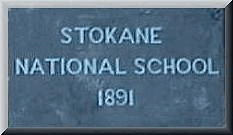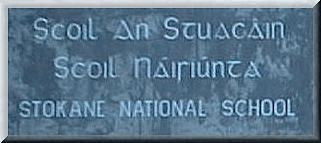
STOKANE NATIONAL SCHOOL
Archive No. 1

 |
STOKANE NATIONAL SCHOOL Archive No. 1 |
 |
|
Stokane National School is one of the 14 primary schools located in a triangle west of the
Ox Mountains in Co. Sligo, (Ireland) and east of Killala Bay. Mrs. Bourke
taught in the junior room and Mr. McMahon taught in the senior room until August 31st 2007. Our
learning support teacher, Ms. Staunton, comes on Tuesdays and Thursdays.
|
|
|
|
The Victorian era (1837 - 1901) saw the onset of many reforms in Ireland as well as the rest of the world. The most notable of these changes in a local context was the establishment of Stokane's first National School in 1845, fourteen years after the system was first established by Stanley. Hedge-schools were present in the parish at this time and an inscription on a headstone in Killanley old graveyard bears the name: Thady Foody, Hedge-school master, Died 1869. Formal education thus had existed in Stokane before 1845, and the school, beside the road-side spring well, was taken into the new system almost immediately on the application of the Parish Priest of the time, Fr. Duffy. The first teacher in the school was Michael Rouse -- the owner of the building used as a school -- who was trained by the 'master (school-master) in Leharrow, Dromore West. The average attendance for the first year was recorded as 60 -- the Great Famine of the 1840s then took its toll. In 1890 the idea of providing a new school The new school was enlarged in 1935, and a new bilingual nameplate inserted in the gable of the new porch while the original, written in English, was buried in the rendering. This plate remained partially hidden until the school was modernised in 1991 -- now both limestone nameplates sit side by side, each telling its own tale. The original caption on the nameplate, which was written in Roman
lettering, appears again in that which replaced it, notably underneath the
Irish version, which used the old Gaelic font. Great credit is due to the local community under the leadership of local Catholic clergy, notably Fr. Martin Halloran and Fr. John George McHale, for finding ways to improve the learning facilities for local scholars -- this great community spirit is still in the area. The invaluable assistance of local public representatives, in particular Mr. Ray McSharry and Mr. Ted Nealon, didn't go unnoticed either. Local councillor, Mr. Paul Conmy, is responsible for providing the welcoming light in the car park at night -- the school is used as a polling station at local and national elections. The Parents' Association -- set up in the mid nineties -- has been responsible for the provision of the school uniform, school tracksuit, additional audio and IT equipment, library books, the organisation of the school transport service, the rota for cleaning the school and the funding of class and school outings -- it is not possible to list everything here. The school took part in a National Parents' Council-sponsored school project on Heritage in 1997 and collected £200 which went towards the cost of a printer. The children also took part in the NPC Cadbury's Quiz on more than one occasion.
If we could go back in time a few hundred million years, we would find
that the whole area around the school would have been under the sea, and
much closer to the equator than its present 54° N 9° W, as can be seen
from the fossils of tropical creatures entombed in the underlying
limestone. As the last of the ice from the Ice Age moved across the area
about 10,000 years ago, it left huge eskers of sand and gravel in its
wake, and several eratics -- boulders of granite weighing several tonnes.
In Scurmore, we see five of these in a circle, known as The Children of
the Mermaid, with a legend to match. The Stone Age farmers worked the land
here and left the well-preserved Kilbride Burial Ground a little way to
the east of the school. A major climatic change occurred then, and bog
grew up slowly at a rate of about a millimetre each year over most of the
flatter land between the sea and the Ox Mountains, rising high over the
dolmens, and capturing them for posterity as no camera or written account
could. (Remember Pompeii in 79 AD??) At Lough Talt -- a short
distance further east -- we have sites of Crannogs or Bronze Age lake
dwellings. Rathmulcah ringfort is a fine example of a 6th century Celtic
Iron Age settlement, on free-draining hilly land -- eskers left by the
retreating ice -- which failed to produce peat. St. Patrick came to the
area the century before this fort was built and Áinle, one of his
followers, built a church here at Killanley -- Cill Áinle -- the ruin of a
later church survives. The Norman Berminghams came here from Athenry and
forced out the O'Dowd's for a time -- they could not stay, however. A
massacre is recorded here for 1798, when a local untrained army met the
advancing British and were slaughtered to the last man. A local priest,
Fr. Owen Cowley, survived the "priest-hunt" after this period and he will
not be forgotten. The local cathedral, St. Muredach's, bears the date 1829
-- the year of Catholic Emancipation. Fr. Owen Cowley's life has yielded
well. Peace reigns in the land at present, and much of the peat which
covered most of the parish when those fleeing from Cromwell in 1649
arrived, is removed and the land reclaimed, revealing fertile fields below
the level of the roads. Some peat is still used to heat the local
dwellings and a small amount is sold in the neighbouring towns. A day in
the bog nowadays is not like it used to be -- the turf-cutting machine has
long since replaced the spade, and school attendance is rarely down due to
having to help at home or on the land. The glacial moraine at Carns is
wisely tapped by a local sand-and-gravel contractor to build farm
buildings and houses. The present generation of children attending the school are reminded of Queen Victoria and her eldest son -- later to succeed her as Edward VII -- on outings to the local town of Ballina where post-boxes stand to the memory of those of a long-forgotten age. The schools they had built as bridges between the home and the wider community still remain, their pupils have stood tall among the tallest, have spoken as well as the most eloquent, and reached heights those denied the system could never hope to aspire to. In 1991, a centenary book, "Stokane .... Moments in Time" was published, and this gives a detailed guide to the main events concerning the school, gleaned from living memory -- a small number of copies are still available. Extracts from the book may be seen on our sister site, Stokane Renuion. Fr. Martin Halloran, a former P.P. in Castleconnor, did some research on the parish and he presented a copy of his work to the school in 1985 -- this is well worth a read, and may well inspire further works. (Fr. Halloran passed away in October 2004. Ar dheis Dé go raibh a anam.) One such publication is "Castleconnor Parish" (An Historical Perspective - Pre 1900). ISBN 0-9538835-0-7 and 0-9538835-1-5 (Hardback) P.S. For a brief history of other national schools in Co. Sligo, see "National Schools of Co. Sligo" ISBN 0 9536065 2 X |
|
|
|
|
|
|
Cuairteoirí |